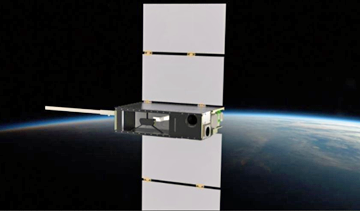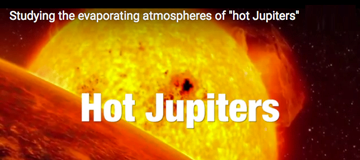
A team led by the University of Colorado's Laboratory for Atmospheric and Space Physics (LASP) scientists, engineers, and students has been selected to build a tiny orbiting satellite to study the evaporating atmospheres of gigantic “hot Jupiters”— distant gaseous planets orbiting scorchingly close to their parent stars.

This artistic rendering of the CUTE spacecraft and instrument — in its sun-synchronous, geocentric orbit — shows the solar panels, communications antenna, optical system, star trackers (lower right, facing front and right), and the computer. Image is Courtesy of LASP.
To date more than 100 gas giants have been discovered orbiting very close to their parent stars, said LASP planetary scientist, Kevin France, principal investigator on the four-year, $3.3 million effort funded by NASA. France and his colleagues believe the new study of hot Jupiters—some of which are so close to parent stars they orbit them in a matter of days—will help planetary scientists better understand the evolution of our own solar system.
The team is building a 6-unit (30 cm x 20 cm x 10 cm) cubesat called the Colorado Ultraviolet Transit Experiment (CUTE), which will carry an ultraviolet telescope to characterize the composition and mass-loss rates of exoplanet atmospheres. The UV region of the spectrum was chosen for study because it is a “sweet spot” both for star brightness and for finding heavy elements.
The researchers plan to measure escaping gases from hot Jupiter atmospheres as the planets transit across the face of their bright parent stars, and will look for evidence of magnetic fields on the gas giants. Some hot Jupiters are losing mass so fast they have tails similar to comets that face away from their parent stars, in large part because stellar winds can blow off stars at more than a million miles per hour.
France said that hot Jupiters are a natural lab for the team to look at atmospheric processes that may have been important in our solar system’s evolution. France, who is also a faculty member in the CU Boulder Department of Atmospheric and Planetary Sciences, add that the atmospheres are pulled along by the stellar wind, which blows them backwards and gives them a comet-like appearance. In the planetary atmospheres of our solar system, the heaviest elements sink. On Earth, elements such as iron and silicon have sunk into the rock mantle, while lighter elements such as nitrogen and oxygen remain in the planet’s atmosphere. What we expect to find on these hot Jupiters is that the mass loss is happening so fast that heavy elements are being pulled from inside the planets and spit into the escaping atmosphere. Anticipated by the team is the witnessing of the signatures of heavy elements like magnesium and iron getting tossed out of the planets as they evaporate.
France added that the team hopes to study between 12 and 20 hot Jupiters during the primary mission, which is expected to launch in early 2020 with the mission lasting from eight months to a year in length. Hot Jupiters orbit their parent stars up to 10 times closer than Mercury, the innermost planet in our solar system, which takes 88 days to orbit the sun.
The CUTE team also includes instrument design leader and LASP research scientist Brian Fleming, CUTE project manager and LASP systems engineer Rick Kohnert, a team of LASP engineers, and several graduate students. In addition, the CUTE team includes researchers from the University of Arizona, the Space Research Institute in Graz, Austria, Trinity College in Dublin, Ireland, the University of Toulouse in France, and the University of Amsterdam in the Netherlands.
France’s team also is collaborating with Blue Canyon Technologies of Boulder, which is building the platform that will house the CUTE payload. The platform will provide the mission’s power, command, data handling, attitude control and communications.


